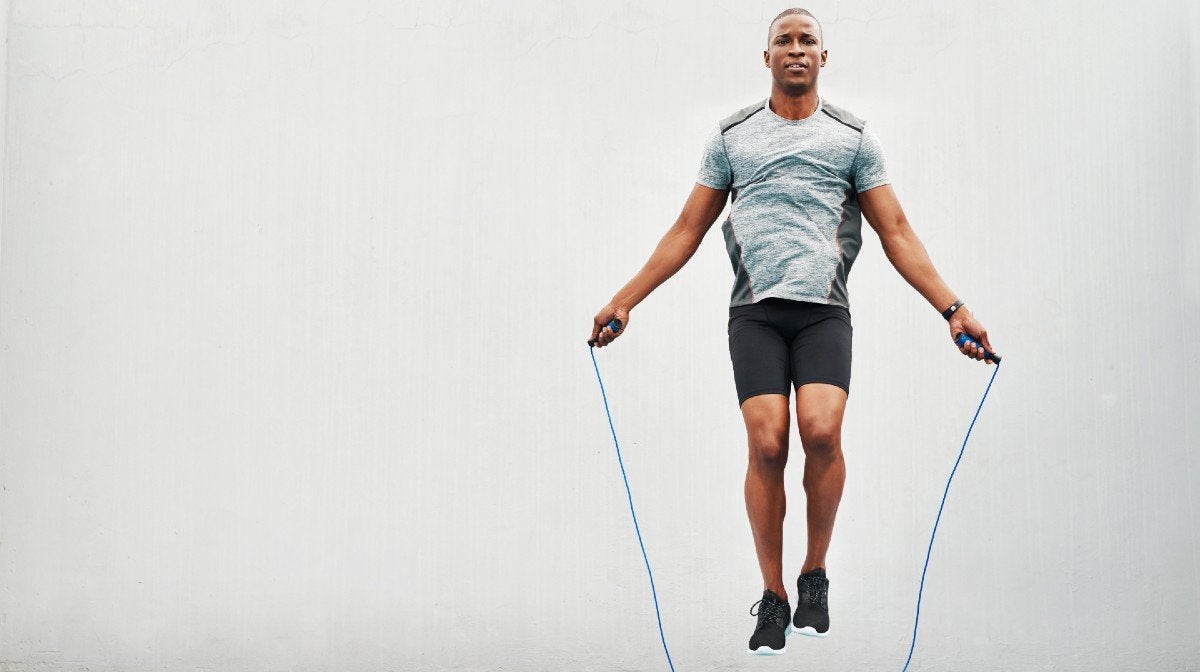
It may be a surprise to some, but skipping is more than just a primary school playground activity or a classic inclusion in any boxing movie training montage (although it's definitely both of those things too).
Skipping is a virtually universally available form of exercise which you can do regardless of where you are, how much time you have and, in most cases, how much space you have.
1. It won't break the bank
This one is a given. Compared to any half decent exercise machine, skipping ropes cost next to nothing. Most machines will set you back a couple of hundred, if not thousands, of pounds whereas you can pick up a skipping rope for the price of your lunch!
2. It's a full-body workout
Skipping is an excellent full body workout recruiting as many muscles as you could possibly think of — your calves, quads, hamstrings, glutes, abs, shoulders and even your arms.
3. Cardiovascular training
Skipping is a great tool for improving cardiovascular fitness. In as little as just a few weeks, studies have found skipping to have a significantly positive impact on both men and women’s cardio. In fact, in one study comparing 30 minutes of daily jogging to 10 minutes of daily skipping it was found that both forms of exercise significantly improved participant’s cardio with 10 minutes of skipping being just as effective as 30 minutes of jogging!1
4. Burns a lot of kcals
Research shows that skipping can burn up to 25 – 30kcals a minute in both men and women, meaning you can burn off up to 600kcals in just half an hour.2 If you’re looking to reach a calorie deficit in order to lose weight, skipping could be the burner you’ve been looking for to reach it without reducing your calorie intake as much.
5. Improves agility
Skipping rope is a great activity to add into your program if you’re involved in any activities or sports involving a high demand for agility. Anecdotally, we can see countless examples of how jumping rope is incorporated into sports training to improve agility (again, ask any boxer how they improve their agility!) but it’s also reflected in research findings too!3
6. Increases variety and flexibility
One of the best arguments to incorporate jump rope into your routine is the variety of workouts you can do. From endurance to interval training to improving power output and the ability to do it virtually any place, any time. There are loads of tricks out there that you can learn — it’s a great way to pass the time and impress your mates.
7. Can make you happier
What is one of the easiest ways to improve your mood? Exercise of course! Performing exercise releases signalling molecules (neurotransmitters) called “endorphins” which can help improve our mood!
Skipping fits perfectly into the zone of moderately intense exercise which may be the best intensity to shoot for to ensure you get the improved mood you’re after.4
8. Improves coordination
Coordination is a critical skill for many sports and general activities throughout the day. Skipping may be a super simple exercise to significantly improve motor skills, balance and overall coordination.
A study found that in as little as two sessions a week for several weeks, skipping improved balance and motor coordination in a sporting population.5 Given the importance of coordination (and balance) in sport, and the fact that athletes can add in jump rope with very little, if any, disruption to their training program, it would be well worth giving it a go to see how it improves your performance.
9. Decreases injury risk
Ok, so skipping seems pretty amazing right? But how does it compare to other exercise injury wise? Well, it may just be top dog in that capacity too…
One study compared running to skipping to investigate the effect these activities can have on our body.6 Researchers compared the contact force on the knee for 20 healthy, young adults when they ran and skipped at the same speed.
Compared to skipping, running produced almost twice the average peak force on the patella or kneecap in the front of the knee joint, the study found.
Running also produced almost 30 percent greater average peak force on the tibiofemoral joint, or the knee hinge formed between three bones: the femur, tibia, and patella.
10. May even make you smarter
According to the Jump Rope Institute, skipping helps with the development of the left and right hemispheres of your brain, which further enhances spatial awareness, improves reading skills, increases memory and makes you more mentally alert.
This has also been reflected in research, highlighting that even as little as 3 minutes of skipping can engage the parts of the brain which are associated with being advantageous for cognitive learning.7
Factoring in how jump rope can influence other cognitive skills, like coordination for example, we can assume that it can actually help make you significantly more intelligent.
Take home message
Despite being one of the simplest forms of exercise, the benefits of skipping are not to be overlooked. And just because our beloved gyms are open again, doesn't mean we should let our skipping ropes gather dust.
From fitness, to weight management, mood, coordination and even intelligence, skipping can help improve all of these factors and more.
Wonderfully cheap, incredibly versatile and easy to pick up, we expect to see a lot more of you including skipping in your routines in the future.
Be sure to tag us in your jump rope workouts — we want to see your skipping skills.
READ THIS NEXT:

10 Basic Yoga Exercises For Beginners | Yoga Made Easy
Roll out your yoga mat and discover the benefits yoga has to offer....

1. Baker, J. A. (1968). Comparison of rope skipping and jogging as methods of improving cardiovascular efficiency of college men. Research Quarterly. American Association for Health, Physical Education and Recreation, 39(2), 240-243.
2. Town, G. P., Sol, N., & Sinning, W. E. (1980). The effect of rope skipping rate on energy expenditure of males and females. Medicine and science in sports and exercise, 12(4), 295-298.
3. Grivedehi, M. B., Nourbakhsh, P., & Sepasi, H. EFFECTS OF SPEEDY AND DEMONSTRATION JUMPING-ROPE TRAINING ON GROSS MOTOR SKILLS.
4. Saanijoki, T., Tuominen, L., Tuulari, J. J., Nummenmaa, L., Arponen, E., Kalliokoski, K., & Hirvonen, J. (2018). Opioid release after high-intensity interval training in healthy human subjects. Neuropsychopharmacology, 43(2), 246-254.
5. Trecroci, A., Cavaggioni, L., Caccia, R., & Alberti, G. (2015). Jump rope training: Balance and motor coordination in preadolescent soccer players. Journal of sports science & medicine, 14(4), 792.
6. McDonnell, J., Zwetsloot, K. A., Houmard, J., & DeVita, P. (2019). Skipping has lower knee joint contact forces and higher metabolic cost compared to running. Gait & posture, 70, 414-419.
7. John, A., & Schöllhorn, W. I. (2018). Acute effects of instructed and self-created variable rope skipping on EEG brain activity and heart rate variability. Frontiers in behavioral neuroscience, 12, 311.








